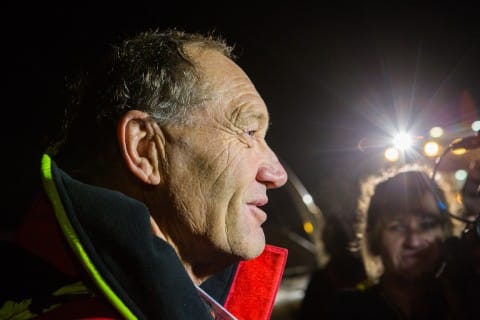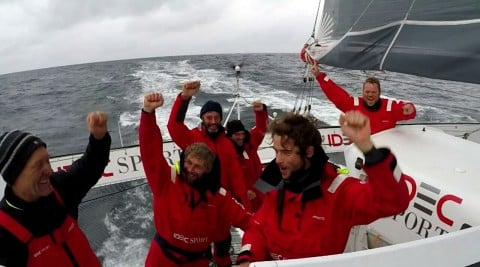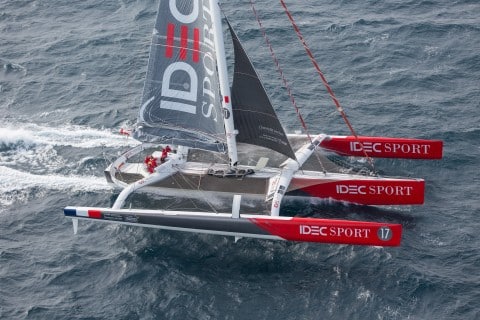
Francis Joyon may have just shattered the Jules Verne record on IDEC Sport , but his latest offshore victory will likely be short-lived, he says. As a new generation of foiling giant trimarans are launched in the near future, it is just a matter of time before crews will be able to best Joyon’s already mind-bogglingly fast world circumnavigation in less than 41 days.
But Joyon certainly owes his latest record to more than just have one of the world’s fastest boats. The successful skipper breaks down the factors that went into IDEC Sport ‘s speedy circumnavigation.
How much did your success in the Jules Verne attempt depend on finding the right weather fronts?
It’s been said in the past that it was impossible to sail faster than the low-pressure zones. But, in fact, we are now able to sail with the low-pressure zones — it’s what we look for. They do not all move at the same speeds, but anywhere from 40 knots to10 knots.
At the end of the Indian Ocean, we were in a low-pressure zone sailing at 35 knots with ideal wind speeds of 25 to 30 knots, and we were able to remain inside it. Our speed was roughly the average maximum speed we were able to maintain with IDEC , while sailing over 900 miles per day. But when this weather front began to lose speed south of New Zeeland, we had to change course in search of another weather front farther south.
In the future, finding ultra-fast low-pressure zones will largely determine when records are broken. A weather front moving at 45 knots and a boat able to sail at the same speed during very long distances could certainly translate into the next around-the-world record.

What kind of boat designs are required to reach average speed of 45 degrees?
Our boat certainly can’t maintain those speeds. Our maximum was a consistent 35-38 knots. Sailing faster than that would have caused major problems. But the next generation of boats will fly like the America’s Cups boats do. They will begin to reflect the true potential of foiling designs and other technologies for offshore sailing. I expect these boats will be able to maintain speeds of 45 knots or even faster.
Boat designers such as Vincent Lauriot-Prevost, who was IDEC‘s architect, are developing these new designs. It is just a matter of time before offshore trimarans will have foils that will lift them out of the water like the current-generation of America’s Cup boats do now.
What are the limits of maintaining 40-knot speeds for days at a time?
I consider myself a good judge of knowing when to hold back. I can say this because I have survived capsizing on one of these boats. I know firsthand that it only takes one or two seconds for these giant trimarans to crash. Someone who has never capsized on one of these boats cannot know exactly when the limit has been reached. It’s a double-edged sword — this awareness creates fear, but it also enables you to know just how far you can go. If you are courageous enough to use this sword, you can go a lot further than you could if you haven’t survived a crash.
This came into play in the Indian Ocean when we were sailing with the low-pressure zones at 35-knot speeds. There was a near-constant risk of capsizing during those weeks. That was when I relied on my first-hand awareness of knowing when to hold back.

In your role as a skipper, how much of the actual helming did you do?
The lads did more of the helming than I did. I largely focused on plotting the course, meteorology, and managing the crew. I was lucky to have been at the wheel as often as I was.
How were the watches organized?
Each crewmember had three hours to sleep. They had an hour and a half of standby time, when they wore their gear and were ready to react quickly when necessary to complete maneuvers. They also spent three hours on deck, taking turns every half an hour by helming or managing the sails. There were always two crew members at all times on deck.
My schedule was different. In many ways, it was as if I were sailing solo. I slept in increments of 20-30 minutes or sometimes for an hour around the clock, for a total of about four to six hours per day. That way, I was able to interact directly with all of the crewmembers at some point each day. Whenever I heard something that didn’t sound right, such as when the boat suddenly slowed down, I would leave my hammock.
How much of a factor were breakages during the Jules Verne this time?
We just had the expected number of breakages, which is par for the course. We did have some problems with a component used to orient the mast, but that did not slow us down too much.
At one point, I had to climb below the net to fix a problem with the spinnaker pole, which attracted a lot of the public’s attention when the video was broadcast. It had to be fixed because the spinnaker pole left dangling began to leave holes in the hull in just a few minutes. Some of the holes were at water level, which made fixing it more of a challenge.









